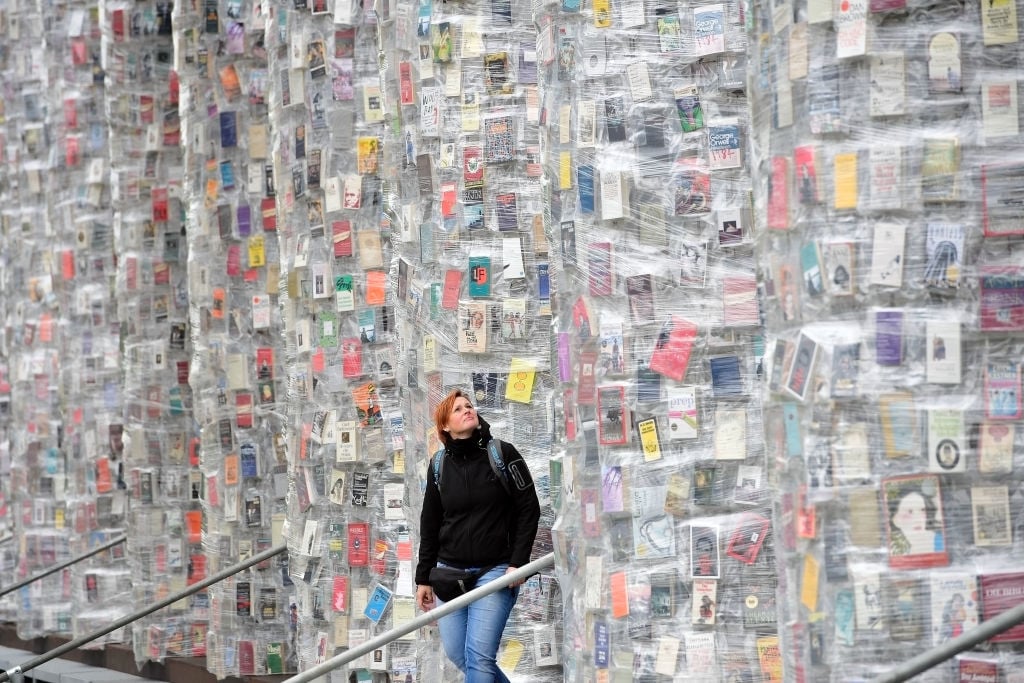
It’s official: documenta 14 is open for business in Kassel. “Learning From Athens,” as the show is called, is big and somewhat confoundingly complex. While more concentrated than in years past, the 2017 affair still takes place over many, many venues, including ones that are difficult to find.
The exhibition does have a heart, of sorts, or at least some central nodes. So, while the ideas percolate and I gather all the data, here are some pictures to give a sense of how the central conceit of “Learning From Athens” plays out across the big venues of the documenta Halle, the Neue Galerie, and the Fridericianum.
Documenta Halle
The official documenta place is where one finds the show’s most lyrical passages, including some of its most joyful painting (a mediumistic rarity in this show). Throughout documenta 14, music is a theme, and here music-related exhibits include a collection of memorabilia relating to the musician Ali Farka Touré (1939-2006), paintings by Alvin Lucier (b. 1931) that actually play sound, and dreamy abstractions by Sedje Hémon (1923-2011) that double as musical scores.
Works by Beau Dick, at documenta Halle. Image: Ben Davis.
A grammy from a collection of objects and archival materials related to Malian musician Ali Farka Touré. Image: Ben Davis.
Lala Rukh, The Unholy Trinity, poster designed by women at a workshop in Koitta, Bangladesh (1986).
Three works by William Pope.L (2001-2002). Image: Ben Davis.
Paintings by Miriam Cahn. Image: Ben Davis.
Paintings by Stanley Whitney. Image: Ben Davis.
Alvin Lucier, Sound on Paper (1985), featuring framed paper, oscillator, and speakers.
Marie Cool Fabio Balducci, Untitled (2003), composed of scotch tape, walls, and desktop.
Aboubakar Fofana, Fundi (Uprising) (2017), various materials, installation view. Image: Roman März.
Works by El Hadji Sy (all 2016). Image: Ben Davis.
Two untitled works by Ernest Mancoba. Image: Ben Davis.
Sedje Hémon’s Flanking Low (1994), part of a series of paintings meant to be used as musical scores. Image: Ben Davis
Christopher D’Arcangelo, Post No Art (ca. 1975). Image: Ben Davis.
Sited outside the documenta Halle: Hiwa K’s When We Were Exhaling Images (2017), each of the big tubes containing a different living environment. Image: Ben Davis.
The Neue Galerie
The Neue Galerie section of documenta takes an unexpected turn into history. Maria Eichhorn’s ongoing investigation into Nazi theft of Jewish goods prefaces a show stacked with historical paintings and artifacts, selected to suggest reckonings with history of various kinds. Among other things, these include sketches by documenta founder Arnold Bode, meant to illustrate his fascination with Greece.
Outside the Neue Galerie, a performer offers samples of Otobong Nkaga’s O8 Black Stone soap, produced in Athens for documenta 14. Image: Ben Davis.
Tower of books from Maria Eichhorn’s Rose Valland Institute (2017), a project which investigates the Nazi looting of Jewish property. Image: Ben Davis.
Amita Sher-Gil, Self-Portrait as a Tahitian (1934). Image: Ben Davis.
Head of a fasting Buddha (2nd-3rd century CE). Image: Ben Davis.
Karl Hofer, Man Among Ruins (1937). Image: Ben Davis.
Arnold Bode, Museum in Athens I (2 korai) (1965); Bode was the founder of documenta. Image: Ben Davis.
Max Liebermann, Rider on the Beach (1909); Liebermann was “Germany’s leading impressionist painter,” who lost his job as the president of the Prussian Academy of Arts in Berlin in 1933 because he was Jewish. Image: Ben Davis.
Alexander Kalderach, The Parthenon (1939); Kalderach’s classical images “constitute the nadir of German philhellenism” in the Hitler period. Image: Ben Davis.
Albert Weisgerber, Theodor Heuss, Adolescent Portrait in Oil (1905). Image: Ben Davis.
Karl Leyhausen, Portrait of Peggy Sinclair (1928); an associate of documenta’s founder Arnold Bode, Leyhausen committed suicide in 1931. Image: Ben Davis.
Erna Rosenstein, Looters (1948 and 1952). Image: Ben Davis.
Ashley Hans Scheirl, Goldenshowner (L’Origine du Monde) (2017). Image: Ben Davis.
Paintings by Cecilia Vicuña. Image: Ben Davis.
Installation view of works by Annie Sprinkle and Beth Stephens. Image: Ben Davis.
Nilima Sheikh, Terrain: Carrying Across, Leaving Behind (2016–17). Image: Ben Davis.
Installation view of works by Alina Szapocznikow. Image: Ben Davis.
Carl Friedrich Echtermeier, National Figures (1876-82). Image: Ben Davis.
Paintings by Pavel Filonov. Image: Ben Davis.
The Fridericianum
In exchange for being a host site for documenta in Athens, Greece’s National Museum of Contemporary Art (EMST) is hosting its collection at the Fridericianum for the duration of this show. The result is a show of unexpected Greek artists, offering a Hellenic alternative history of recent art. These are interspersed with a variety of artists from further afield whose work often (though not always) seems to have a place in the EMST because of Greek themes.
Banu Cennetoğlu’s BEINGSAFEISSCARY, (2017) on the exterior of the Fridericianum. Image: Ben Davis.
Nikos Alexiou’s animation The End (2007). Image: Ben Davis.
Andreas Angelidakis, Polemos (2017). Image: Ben Davis.
Chryssa, Chicago Chinatown (1990). Image: Ben Davis.
Jannis Kounellis, Untitled (1993). Image: Ben Davis.
Kimsooja, Bottari (2005). Image: Ben Davis.
Lucas Samaras, Hebraic Embrace (1991-2005). Image: Ben Davis.
Takis, Telelumiere colonne (1966). Image: Ben Davis.
Kendell Geers, Acropolis Redux (The Director’s Cut) (2004). Image: Ben Davis.
Installation view of Oliver Ressler’s What Is Democracy? (2009). The work features interviews with people from many countries talking about the failures of democracy as their flags burn. Image: Ben Davis.
Dimitris Alithinos, A Happening (1973). Image: Ben Davis.
Kostis Velonis, Life Without Democracy (2009). Image: Ben Davis.
Costas Tsoclis’s video projected on acrylic on cloth. Image: Ben Davis.
George Lappas, Abacus (1988). Image: Ben Davis.
Andreas Lolis, Shelter (2013-16). Image: Ben Davis.
Stelios Faitakis, Fortunately absurdity is lost (but they have hoped for much more) (2014). Image: Ben Davis.
Installation view of neon and foil works by Stephen Antonakos (all from the late 1980s). Image: Ben Davis.
Mona Hatoum, Fix It (2004). Image: Ben Davis.
Yorgos Sapountzis’s “The Landscapes of Greece” series (2014). Image: Ben Davis.
Haris Epaminonda, Untitled #09p/g (2012). Image: Ben Davis.
Performers working with an archive of images relating to recent Greek history for Stefanos Tsivopoulos’s The Precarious Archive (2015). Image: Ben Davis.